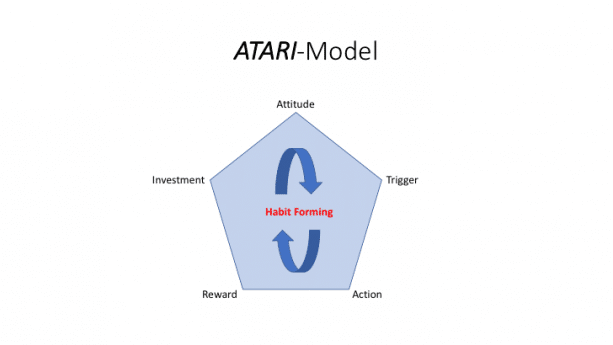Written by Ali Fenwick, Professor of Industrial-Organizational Psychology at Hult.
Ever wonder why you spend so much time on your mobile phone reading posts on Facebook, playing Candy Crush or other mobile games, or texting on WhatsApp, when initially you only planned to post a quick selfie on Instagram or retweet something on Twitter?


This article will reveal the design techniques used by social media site designers to keep you hooked on their apps. It will also introduce to you some core psychological and neurological principles that will help explain how these simple but effective design strategies can turn ordinary people into ‘online junkies’.
‘Habits die hard’
When we think of habits, we often think of behaviors which unconsciously creep into our lives and drive many of our daily routines. We tend to think of habits as good or bad. Brushing your teeth in the morning or going to the gym after work can be considered good habits. Smoking regularly or eating junk food are generally considered bad habits. What both good and bad habits have in common, are their ability to help the brain preserve critical cognitive resources. This can then be used for more important mental tasks such as decision-making and self-control regulation.
It is often said that ‘habits die hard’, and the reason for this lays in how habits form in our brain. When we do something we like and accomplish the task at hand, our reward system in our brain (the mesolimbic dopamine system to be exact), produces a hormone called dopamine. Dopamine (otherwise known as the happiness hormone) make us feel good, so we tend to repeat behaviors that give us pleasure. Over time, these behaviors (done repeatedly) turn into habits and become hardwired in the brain, making it both difficult and unpleasant to undo.
This habit-forming process is fundamental to how social media developers design mobile apps and online platforms. Using the ATARI-model of habit formation, I will explain the common steps used by app developers, growth hackers, mobile game creators to induce habit-forming behaviors in their users.
ATARI-Model.
ATARI stands for Attitude, Trigger, Action, Reward, Investment (so no reference to the 80’s video game computer).


- Attitude: This dimension of the model refers to the psychological profile of your user. Understanding your users’ personality, behavioral preferences, likes, desires, opinions and motivation (otherwise known as psychographics) will help you to understand ‘WHY’ they would use your social media site, product or service. Most (social media) mobile apps and online platforms collect user psychographic data.
- Trigger: Triggers are notifications that inform you to take action. Before habit-forming behaviors can be created, behaviors first need to be initiated. According to BJ Fogg’s Behavioral Model, triggers need to be easy to execute and appealing to do. Especially the appealing part is really important, that is why ‘Attitude’ precedes ‘Trigger’. If you know why someone will take action, your triggers can be designed to appeal to their immediate needs.
- Action: Once a successful ‘Trigger’ has initiated behavior, ‘Action’ can be taken to fulfill the task at hand and thus help fulfill that immediate need. Take, for example, clicking on an Instagram notification to view your friends’ latest pictures or seeing who liked your posts.
- Reward: The most insidious dimension of the ATARI model is ‘Reward’. Getting 100 likes on your Facebook post or finding the perfect match on Tinder is just the reward you have been expecting for the effort you have put into achieving your goal. However, if you think carefully about your social media usage, you don’t always get rewarded for scrolling on your timeline. When rewards are unexpected, the science of human behavior shows us that people will continue that behavior in anticipation of a reward. Scrolling your timeline is like pulling the handle of a slot machine and playing the lottery.
- Investment: The final dimension refers to the time, data, social capital, and/or money that is put into using the app as ‘Investment’. Behavioral Science shows that people don’t like to part with things or people where an investment has been made in. This is often referred to as ‘loss aversion’ in psychology. In addition, the fact of investing time or money into something validates our previous behaviors, self-justifying continuous use.
The ATARI-model is a recurring loop people go through which solidifies behaviors, inducing habit formation in social media usage. I created the personality-driven ATARI-model, based on Nir Eyal’s Hook-Model, expanding his original model with psychological profiling (attitude).
Taking stock
Now that you are aware of how to create habit-forming behaviors online, think of how you could make use of the ATARI-Model to (ethically) create habit-forming behaviors within your business or with your clients, or maybe with your friends or loved ones.
Finally, use the learnings from these habit-forming strategies to consider your own social media usage and behavior. If you find yourself spending too much time online and aim to lower your mobile phone usage, try to devise some personal strategies to help you with accomplishing this. Some of my favorite strategies are:
- Only use social media in the morning before getting out of bed or during commutes.
- Agree with friends not to use your mobile phones during dinner or meet-ups.
- Create a mobile-free day once a week
- Temporarily deactivate your account
One last note…
Habits and addictions form in the same part of the brain. The only difference being the level of self-control we exert to prevent a habit turning into an addiction. Over-reliance on habits can suspend critical mental tasks like decision-making, judgment and self-control management. Most of these strategies help hack our brain by helping us to overcome self-control issues. Give your automatic brain some downtime, and try some of these strategies to lower your mobile phone and social media usage.
Want to learn more about social media design?
- Sign-up for a free Masterclass on ‘The Psychological Addictive Elements of Social Media Design’ where Ali Fenwick and his team will share with you recent study findings on social media usage:01 February 2018 at 18:00 – 20:00 CET, Rotterdam. Limited places available. Registration: send an email to info@leadtcml.com.
- Ali Fenwick is also offering a free online course in Behavioral Mobile App Design? Click here for more.
- See Ali Fenwick share more management psychology at his recent TEDx talk. Watch now.
If you would like to find out more about Hult’s business programs, download a brochure here.
Make the most of what your career has to offer with a Masters in International Business from Hult. To learn more, take a look at our blog Social media and the increasing importance of virtual networks in business, or give your employability a huge boost with an MBA in international business. Download a brochure or get in touch today to find out how Hult can help you to explore everything about the business world, the future, and yourself.


